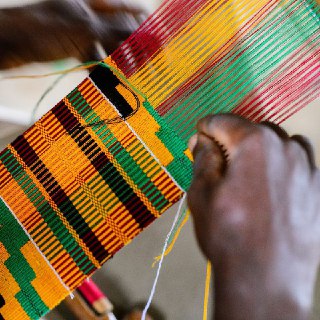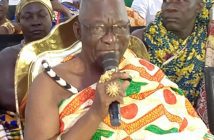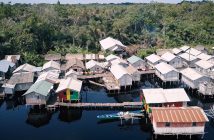An author once said, “The legacy of heroes is the memory of a great name and the inheritance of a great example.” —Benjamin Disraeli.
The people of Tafi Abuife, located in the Ashanti region of Ghana, have found it necessary therefore to leave a great example by, teaching their offsprings kente weaving as an inheritance to them. This is the story of how it all began.
Kente, a colourful Ghanaian traditional fabric which is worn mostly on important occasions and celebrations, was developed around 17th Century A.D by the people of the Ashanti Kingdom, it can be traced back to the long tradition of weaving in Africa dating back to circa 3000 BC. The origin of Kente is grounded in both legends and history.
According to the legend, a man named Ota Karaban and friend, Kwaku from a town called Bonwire (currently the leading town for the production of Kente in Ghana) had their weaving lessons from a spider that was weaving its web. These two hunters found an exceptional web, and studied its designs and patterns for two days. Afterwards, they returned to their village to implement what they had seen. These two later told their story to the Nana (Chief) Bobie, who passed on the important news to the paramount chief of the Ashantis- the Asantehene. The Asantehene did not hesitate in adopting the fabric for all Ashantis as a national cloth for special occasions like funerals, festivals, naming ceremonies and marriage ceremonies.
Along the line, the production was improved but the name was retained which subsequently became “Kente”. It is also said that Kente was originally designed from Bonwire. Bonwire is located 18 km off the Kumasi – Mampong road. It is a settlement with hundreds of Kente weavers.
Historically, the origin of kente weaving could be traced to the traditions of the ancient West African kingdoms between 300 A.D and 1600 A.D. Some historians are of the view that Kente is a development of various weaving traditions that existed around the 17th century. Nevertheless, while the Kente Cloth may have its origin from around the 11th century of West African weaving traditions, the art of Kente weaving developed earlier in Africa. In some parts of Africa, archeological excavations have revealed weaving instruments like spindles whores and loom, weights in early Moroe Empire.
Kente, now Ghana’s national cloth is one locally made handicraft that has won world wide recognition. There are many types of Kente each with its own symbolism and name, which tells the history, culture and social practice of the weavers of the cloth. Kente was declared a national cloth on the attainment of independence on 6th march 1957. It is used for different purposes and at different functions.
It is important to note that Kente is used not only for its beauty but also for its representational symbolism. The weaver derives names and meaning from moral values, oral literature, philosophical concepts, human behavior, individual achievements, animal life, proverbs and social code of conduct.
The beauty of a kente cloth is affected by the colour symbolism. Colours are chosen for both their symbolic effect and visual effect. A weaver’s choice of a colour may also be influenced by his tradition or a matter of preference. Gender plays a key role in the selection of colours as women are mostly known to prefer pink, purple, light yellow and light blue etc while males cherish black, dark blue, dark yellow, orange, red and dark green.
There are about 50 types of Kente patterns with the most reputable and expensive of all the patterns in the Asanti culture being “Adwene asa” which is translated as my skills are exhausted. It is indeed the last word in the Kente cloths, one in which the strips join all the known designs. It was created only for the kings of the Ashantis and only one master craftsman can weave it. Sometimes weavers compose new designs of honour. Example is one called “Fathia Fata Nkrumah” meaning Nkrumah merit Fathia was created in 1960 for Ghana’s first president Dr. Kwame Nkrumah and his Egyptian wife madam Fathia.
A variety of hand woven Kente fabrics are obtained in many of their local shops at Bonwire. Kente is woven on ancient hand looms. They operate the loom with their hands and feet. The needle, which tread the wrap are placed between the toes. A shuttle passing from the left hand to the right hand in swift movements inserts the yarn/thread/fabric. Simultaneous with the action comes the Kente loom music, a well known noisy Kro-hin-kro … Kro-hin-kro. This rhythm made by the vibrating shuttle as they entwine the coloured yarns smoothly over one another to produce the beautiful double – weave strips of cloth. The strips are sewn together to make the required sizes.
It is as a result of this creativity introduced by the two young men, Kwaku and Ota Karaban, that Tafi Abuife has become one of the largest kente village in Ghana.
In this village, it is the custom that, every child is taught the art of weaving kente upon reaching the age of seven as a birthright, responsibility, and means of making money. The ‘click clack’ sound of looms can be heard across the village according to tourists.
Kente weaving which was inspired by intricate spider webs in the ancient forests of Ghana, was known as the ‘cloth of kings’ due to the cost and time required to weave it. Even with modern-day technology, it is still woven by hand. Each strip is classified by the number of weaves used to make it. According to the weavers, a single weave takes five hours to complete, a double weave takes seven hours, and a triple weave takes nine hours.
Everything about kente is symbolic, from the colors, symbols, and geometric designs. Common designs include those of unity, birds, hills, and our footprints as human beings.
The ‘weaving houses’, are structured in a sweatshop-like building, built by the then government to ensure that kente could still be produced during the rainy season. There are three of these buildings in all.
All in all, it is an artistic and legendary way of leaving a legacy behind. Great work done, oh people of Tafi Abuife.
REFERENCES
1. Available online at, https://touringghana.com/bonwire-kente-weaving-village/
2. Available online at, http://www.averysegal.com/2012/05/22/tafi-abuife-kente-village/





